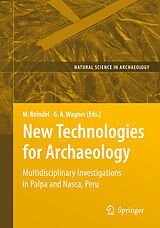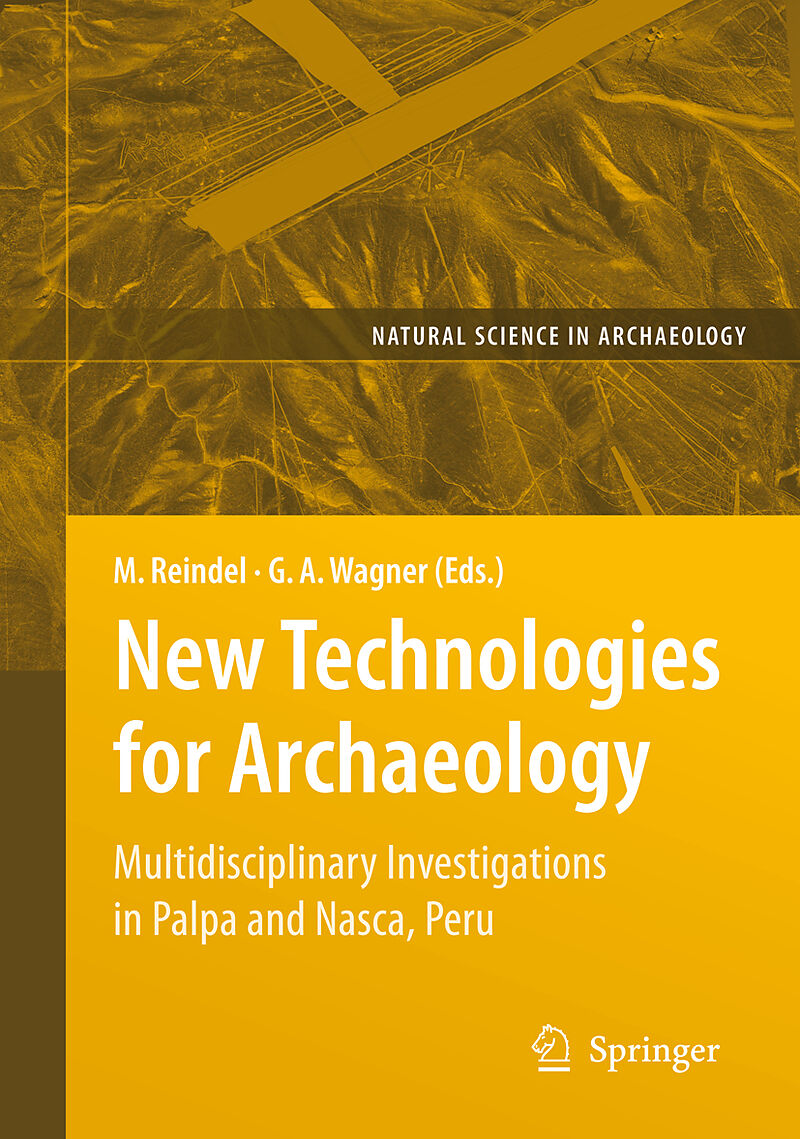New Technologies for Archaeology
Einband:
Kartonierter Einband
EAN:
9783642099540
Untertitel:
Multidisciplinary Investigations in Palpa and Nasca, Peru
Herausgeber:
Springer Berlin Heidelberg
Auflage:
Softcover reprint of hardcover 1st ed. 2009
Anzahl Seiten:
532
Erscheinungsdatum:
21.10.2010
ISBN:
3642099548
This heavily-illustrated book covers recent developments in archaeometry and offers a multidisciplinary approach to reconstructing complex cultural histories. It also presents a detailed history of human development in South America's Nasca region.
In 2002 the multidisciplinary research project Nasca: development and adaptation of archaeometric techniques for the investigation of cultural history (Nasca: Entwicklung und Adaption archa ometrischer Techniken zur Erforschung der Kulturgeschichte) started, funded by the German Federal Ministry of Education andResearch(Bundesministerium fu r Bildung und Forschung, BMBF ) in its priority program New scientific methods and technologies for the humanities (Neue Naturwissenschaftliche Methoden und Technologien fu r die Geisteswissenschaften, NTG). This new project continued and in a certain way fulfilled a lasting goal of the ministry to integrate different branches of scientific activities and to foster the transfer of expertise gained in natural sciences to the humanities and vice versa. Archaeometry, by definition the application of scientific methods in archaeological investigation, has been a major focus of the priority program since its beginnings in 1989. After funding numerous fruitful research projects that developed new archaeometric techniques mostly in bilateral cooperation, an even greater outcome was expected from a more multifaceted approach with the participation of various scientific disciplines around a well-defined, archaeological research topic. Furthermore, it was intended to establish a project outside the traditional research areas in central Europe or the Mediterranean. It was the great merit of the person formerly in charge of the BMBF priority program, Dr. Edgar Pusch, to develop these far-reaching perspectives and we are extremely grateful that after a rigorous screening our project among other interesting ones was selected for funding.
Includes supplementary material: sn.pub/extras
Autorentext
Markus Reindel is an archaeologist specialized in South American and Mesoamerican cultures. He earned his Ph. D. degree at the University of Bonn in Germany. He carried out archaelogical fieldwork in northern Peru, on the coast of Ecuador, in Yucatan, Mexiko and again in Peru, where he is engaged in the investigation of the Nasca culture during the last ten years. Günther A. Wagner directed the Research Group of Archaeometry, Heidelberg Academy of Sciences, situated at the Max-Planck-Institute for Nuclear Physics, and was at the same time professor for geology at the University of Heidelberg. After his retirement in 2006 he joined the Department of Geography. In 1999 he became the first president of the German Archaeometric Society. He is member of the German Archaeological Institute. He has authored/coauthored several books and numerous articles. He acted as Managing Editor of the journal 'Archaeometry' and still is Editor of the series 'Natural Science in Archaeology'. His research topics are archaeochronometry, archaeometallurgy and geoarchaeology.
Klappentext
In 2002 the multidisciplinary research project Nasca: development and adaptation of archaeometric techniques for the investigation of cultural history (Nasca: Entwicklung und Adaption archäometrischer Techniken zur Erforschung der Kulturgeschichte) started, funded by the German Federal Ministry of Education andResearch(Bundesministerium fu r Bildung und Forschung, BMBF ) in its priority program New scientific methods and technologies for the humanities (Neue Naturwissenschaftliche Methoden und Technologien fu r die Geisteswissenschaften, NTG). This new project continued and in a certain way fulfilled a lasting goal of the ministry to integrate different branches of scientific activities and to foster the transfer of expertise gained in natural sciences to the humanities and vice versa. Archaeometry, by definition the application of scientific methods in archaeological investigation, has been a major focus of the priority program since its beginnings in 1989. After funding numerous fruitful research projects that developed new archaeometric techniques mostly in bilateral cooperation, an even greater outcome was expected from a more multifaceted approach with the participation of various scientific disciplines around a well-defined, archaeological research topic. Furthermore, it was intended to establish a project outside the traditional research areas in central Europe or the Mediterranean. It was the great merit of the person formerly in charge of the BMBF priority program, Dr. Edgar Pusch, to develop these far-reaching perspectives and we are extremely grateful that after a rigorous screening our project among other interesting ones was selected for funding.
Inhalt
New Methods and Technologies of Natural Sciences for Archaeological Investigations in Nasca and Palpa, Peru.- New Methods and Technologies of Natural Sciences for Archaeological Investigations in Nasca and Palpa, Peru.- Geoarchaeology.- Man and Environment in the Eastern Atacama Desert (Southern Peru): Holocene Climate Changes and Their Impact on Pre-Columbian Cultures.- Built on Sand: Climatic Oscillation and Water Harvesting During the Late Intermediate Period.- Geophysics.- Beneath the Desert Soil Archaeological Prospecting with a Caesium Magnetometer.- Quantum Detection Meets Archaeology Magnetic Prospection with SQUIDs, Highly Sensitive and Fast.- Viewing the Subsurface in 3D: Sediment Tomography for (Geo-)Archaeological Prospection in Palpa, Southern Peru.- The Field of Sherds: Reconstructing Geomagnetic Field Variations from Peruvian Potsherds.- Bioarchaeology.- From Hunters to Regional Lords: Funerary Practices in Palpa, Peru.- Talking Bones: Bioarchaeological Analysis of Individuals from Palpa.- Who Were the Nasca? Population Dynamics in Pre-Columbian Southern Peru Revealed by Ancient DNA Analyses.- Humans and Camelids in River Oases of the IcaPalpaNazca Region in Pre-Hispanic Times Insights from H-C-N-O-S-Sr Isotope Signatures.- The Nasca and Their Dear Creatures Molecular Genetic Analysis of Pre-Columbian Camelid Bones and Textiles.- Archaeochronometry.- Of Layers and Sherds: A Context-Based Relative Chronology of the Nasca Style Pottery from Palpa.- The Clock in the Corn Cob: On the Development of a Chronology of the Paracas and Nasca Period Based on Radiocarbon Dating.- Cold Light from the Sediments of a Hot Desert: How Luminescence Dating Sheds Light on the Landscape Development of the Northeastern Atacama.- Light Thrown onHistory The Dating of Stone Surfaces at the Geoglyphs of Palpa Using Optically Stimulated Luminescence.- Geomatics.- Virtual Archaeology New Methods of Image-Based 3D Modeling.- Virtual Flight Over the Nasca Lines Automated Generation of a Photorealistically Textured 3D Model of the Pampa de Nasca.- Context Matters: GIS-Based Spatial Analysis of the Nasca Geoglyphs of Palpa.- A Model Helicopter Over Pinchango Alto Comparison of Terrestrial Laser Scanning and Aerial Photogrammetry.- Perspectives and Contrasts: Documentation and Interpretation of the Petroglyphs of Chichictara, Using Terrestrial Laser Scanning and Image-Based 3D Modeling.- Pottery Plotted by Laser 3D Acquisition for Documentation and Analysis of Symmetry of Ancient Ceramics.- Archaeometallurgy.- Gold in Southern Peru? Perspectives of Research into Mining Archaeology.- Fingerprints in Gold.- Summary.- Life at the Edge of the Desert Archaeological Reconstruction of the Settlement History in the Valleys of Palpa, Peru.

Leider konnten wir für diesen Artikel keine Preise ermitteln ...
billigbuch.ch sucht jetzt für Sie die besten Angebote ...
Die aktuellen Verkaufspreise von 6 Onlineshops werden in Realtime abgefragt.
Sie können das gewünschte Produkt anschliessend direkt beim Anbieter Ihrer Wahl bestellen.
Loading...
Die aktuellen Verkaufspreise von 6 Onlineshops werden in Realtime abgefragt.
Sie können das gewünschte Produkt anschliessend direkt beim Anbieter Ihrer Wahl bestellen.
| # | Onlineshop | Preis CHF | Versand CHF | Total CHF | ||
|---|---|---|---|---|---|---|
| 1 | Seller | 0.00 | 0.00 | 0.00 |
